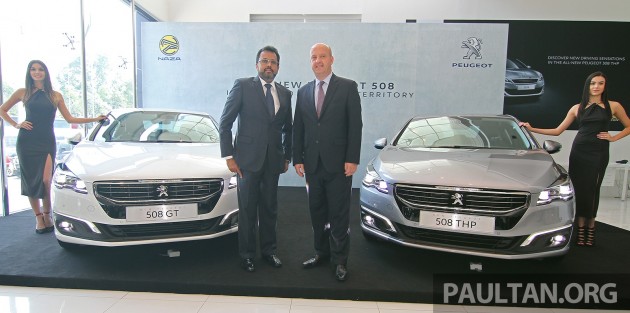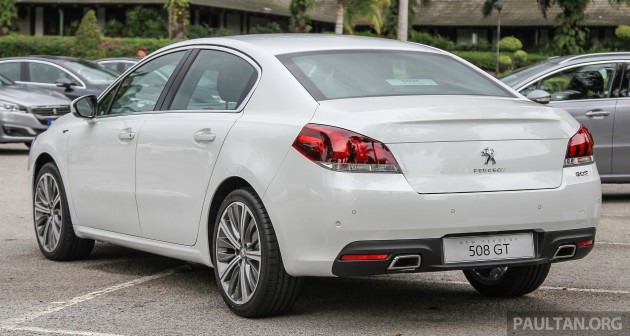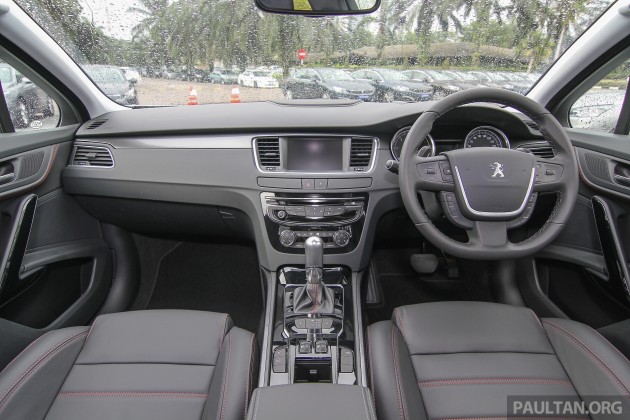
Previewed earlier this month, the facelifted Peugeot 508 has now been officially launched by Nasim. The refreshed D-segment contender takes over from the original 508 that was first introduced here in October 2011 (relaunched with new variants in June 2012), almost four years ago. The facelift is not only a big one then, but a timely one too.
The in-your-face new grille is more vertical than before and houses a big lion in the middle, with a Peugeot script above - the cue is also seen on the upcoming new 408, 308 GT and concept cars like the Exalt.
All front lighting – headlamps, daytime running lights, direction indicators, foglamps (with cornering assist) – are LEDs. The visual signature – a curve - is provided by the DRLs. Also redesigned is the bonnet, which is now more horizontal to match the new cliff-like nose.

The rear end of the D-segment sedan is said to be more 'structured' now, with a redesigned rear bumper that's more prominent. The rear lamps have also been reshaped, with a revised opalescent thick three-claw signature. Slight change in the dimensions - the sedan is 38 mm longer (at 4,830 mm), with 16 mm going into the front overhang and 22 mm going into the rear. The wheelbase is as before, 2,817 mm.
The sedan's boot is capable of 545 litres, expandable to 1,244 litres with the rear seats folded (up to the window line). The SW's estate body holds more of course - 660 litres up to the window line, or 1,865 litres floor-to-roof with the rear seats folded.
Malaysia gets a smaller range than before. For now, three variants of the new 508 are available - the petrol THP sedan and SW, and the diesel GT sedan (the old Turbo S and GT SW are no more). The THP cars are powered by an updated 'Turbo High Pressure' 1.6 litre direct injection engine with 165 PS and 240 Nm of torque from 1,450 to 4,250 rpm. 0-100 km/h is done in 9.2 seconds and top speed is 220 km/h. Peugeot quotes fuel consumption of 7.1 litres per 100 km (14.1 km/l) in the European combined cycle.
Under the range-topping GT sedan's hood is a 2.2 litre HDi FAP engine packing a strong 206 PS and 450 Nm of torque from 2,000 to 2,750 rpm. The benchmark century sprint is completed in 8.4 seconds before the big sedan reaches 235 km/h, although in our experience, it's a lot more forceful in real world driving than the figures suggest. Rated FC is 5.7 litres of diesel per 100 km (17.5 km/l). Both THP and HDi are mated to a six-speed Aisin torque converter automatic with steering paddle shifters.
Like before, GT-spec 508s have double-wishbone front suspension with drop-link hub carriers, while the THP makes do with MacPherson struts. Rear multi-links are standard across the range. The faster and heavier GT also comes with bigger 340 mm disc brakes at the front.
Inside, the still contemporary dashboard is unchanged at a glance, but upon closer inspection, the iDrive-style controller between the seats is gone, and in its place is a new storage compartment with lid. Doesn't fully address the 508's lack of cabin storage spaces, but it's better than nothing.

With the controller gone, the central screen is now a seven-inch HD touch screen (same size as before), but unlike in the new 308, there are shortcut buttons for the air con, navigation and audio system on the centre console. Speaking of tunes, there's a 'jukebox' with 8GB capacity linked to a JBL 10-speaker 500W system with subwoofer. Smartphone connectivity is via USB and Bluetooth.
As before, the 508 is very well equipped. Standard across the board are keyless entry with push start, smart beam (auto high beam whenever possible), electronic parking brake, auto headlamps and wipers, quad-zone automatic air con with rear vents, eight-way electric front seats with electric lumbar support, leather, front/rear park assist (now with reverse camera) and a retractable and smoked head-up display, now in colour.
Previous i-Drive-style controller makes way for an extra cubby; 7in central display now an HD touchscreen
The GT sedan adds on Nappa leather upholstery (not mentioned, but we see red stitching on the seats and gear gaiter), memory plus massage functions for the driver's seat, and a 'GT' badge on the grille and front wings. It rolls on 19-inch alloys with 235/40 rubber, an inch larger than the THP's wheels (235/45 R18). The GT's lower rear bumper also has a unique design, with two visible pipes.
Unique to the SW THP are two wagon specials - a motorised tailgate and a huge panoramic glass roof with electric shutter system and one-touch rotary control.
This is a French car, so five Euro NCAP stars are a given. Six airbags (front, side and curtain) are standard, along with two Isofix mounts and ESP. Peugeot says that the new 'curved' front seat head restraints with multi-position adjustment (no fixed intervals) were shaped to take into account the effects of whiplash in rear collisions. A Blind Spot Sensor System (using front/rear bumper sensors) make an appearance on the 508.
GT-spec adds on Nappa leather, memory + massage functions for the driver's seat and 19-inch rims
The Peugeot 508 facelift range starts from RM175k for the THP Sedan, while the THP SW is yours for a RM10k premium at RM185k. The diesel-powered GT Sedan comes in at RM205k. The estimated prices are on-the-road including GST and insurance.
As usual for Peugeot, buyers get a five-year unlimited mileage warranty (three years factory + two years extended) plus 24-hour assistance. Peugeot Privilege and the use of the Peugeot Lounge at Subang airport are also included.
As usual, head to CarBase.my for a detailed look at the specs of all three Peugeot 508 variants (sedan and wagon), and the colours available.
Peugeot 508 THP Sedan
Peugeot 508 GT Sedan
Peugeot 508 THP SW



No comments:
Post a Comment